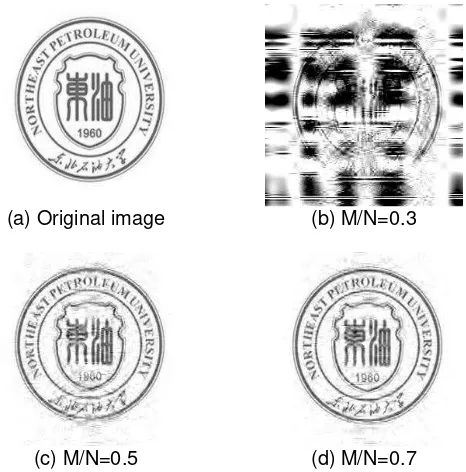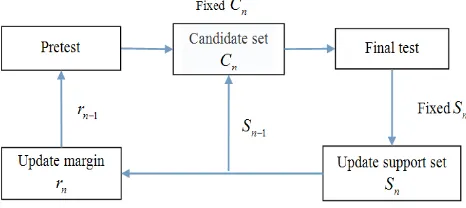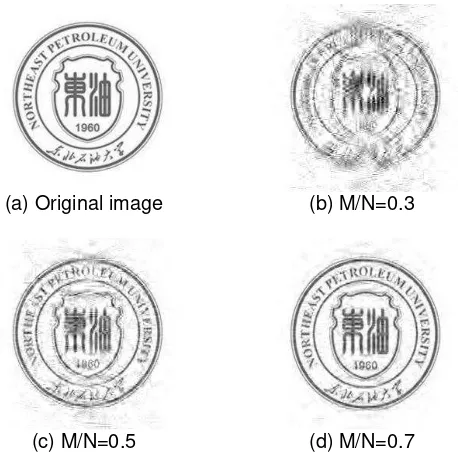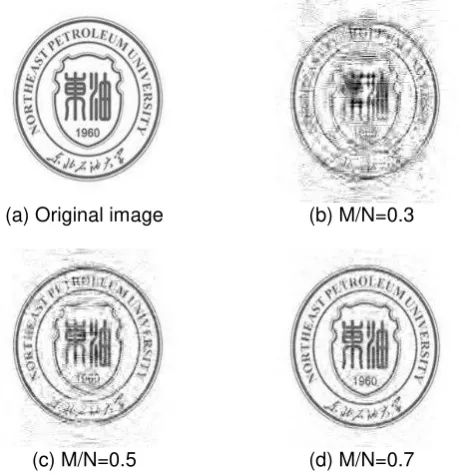DOI: 10.12928/TELKOMNIKA.v15i1.3710 299
A Study on Image Reconfiguration Algorithm of
Compressed Sensing
Yubo Zhang*, Dongmei Wang, Lingling Kan, Panpan Zhao
School of Electrical Information Engineering, Northeast Petroleum University, Daqing 163318, China *Corresponding author, e-mail: [email protected]
Abstract
Compressed sensing theory is a subversion of the traditional theory. The theory obtains data sampling points while achieves data compression. The main content of this thesis is reconstruction
algorithm. It’s the key of the compressed sensing theory, which directly determines the quality of reconstructed signal, reconstruction speed and application effect. In this paper, we have studied the theory of compressed sensing and the existing reconstruction algorithms, then choosing three algorithms (OMP, CoSaMP, and StOMP) as the research. On the basis of summarizing the existing algorithms and models, we analyze the results such as PSNR, relative error, matching ratio and running time of them from image signal respectively. In the three reconstruction algorithms, OMP algorithm has the best accuracy for image reconstruction. The convergence speed of CoSaMP algorithm is faster than that of the OMP algorithms, but it depends on sparsity K quietly. StOMP algorithm on image reconstruction effect is the best, and the convergence speed is also the fastest.
Keywords: compressed sensing, image processing, reconstruction algorithm
Copyright © 2017 Universitas Ahmad Dahlan. All rights reserved.
1. Introduction
Signal reconstruction algorithm is the core section of compressed sensing theory. The researchers proposed a series of algorithm to obtain sub optimal solution, such as minimum L1 regularization, Greedy iterative matching pursuit algorithm, Iterative threshold method, the minimum total variational method which is specially processed for the two dimensional images, and so on. Greedy pursuit algorithm has better reconstruction effect. So it is main algorithms in the present study [1-3].
In this paper, we study and analyze several greedy algorithm in the compressed sensing signal reconstruction algorithm. In actual application the greedy algorithm is more meaningful than the convex optimization algorithm, and the greedy algorithm can meet the quality requirements of signal reconstruction in most cases, and even some of the quality of the greedy algorithm is better than the convex optimization algorithm. Based on compressed sensing theory and the existing reconstruction algorithm, the reconstruction algorithm based on the matching pursuit is studied, and a new algorithm is proposed, which is the step orthogonal matching pursuit algorithm.
2. OMP Algorithm Principle and Simulations
Matching Pursuit Algorithm (MP) is a greedy iterative algorithm, the basic idea is to choose the most matched atoms from the over-complete atomic library which means the measurement matrix to perform a sparse approximation. At the same time find the balance, and then choose the most matched atoms to the signal margin. After several iterations, the signal can be linearly represented by a number of atoms. However, because the signal projection on the vector set of selected atom i.e. measurement matrix column, which makes the results of each iteration may not be optimal, so multiple iterations are needed in order to obtain a good convergence [4, 5].
algorithm uses a lot of probability to reconstruct the original signal accurately, and the speed is faster than the minimum L1 norm method.
2.1. The Core Idea of OMP Algorithm
In the OMP algorithm, the reconstruction of the signal is realized by using the iterative method. Firstly, we obtain the column vector of the atoms in the observation matrix by means of multiple iterations and gradual selections [6]. Each iteration must ensure that selected atom has the largest correlation with the current residual (redundant) vector, and then subtracting the relevant part from the observation vector to update the residual vector, until the number of iterations achieves the sparsity K, and then stop iteration. Since the OMP algorithm will do orthogonal processing to all searched atoms before the projection of the signal, which is largely to increase the complexity of the OMP algorithm, resulting in signal reconstruction time longer.
2.2. Simulation of Image Signal Reconstruction Based on OMP Algorithm
In processing image, we need to transform the image, such as FFT, DCT, wavelet transform, transform the image into the sparse coefficient of the corresponding base, then the coefficient matrix is processed, and finally we can get the sparse restructure of the image by transforming back the processed coefficient.
In this paper, we use DWT for image processing. Firstly, we did gray-scale image
processing to “a school badge”, then reconstructed the image by using DWT, observed the recovery effect in different sampling rate at the same time. Since the recovery effect is very poor when the sampling rate is less than 0.3, therefore, the paper selected sampling rate (M/N) were 0.7, 0.5, 0.3. The effect of image restoration is shown in Figure 1.
(a) Original image (b) M/N=0.3
(c) M/N=0.5 (d) M/N=0.7
Figure 1. Badge Gray-Scale Results Reconstructed from OMP Algorithm in Different Sampling Rates
In order to compare the effect of OMP algorithm in different sampling rates, Table 1 shows the PSNR value and recovery time after the reconstruction of OMP algorithm in the sample rate of 0.3 ~ 0.7.
Table 1. Comparison of PSNR and Time under Different Sampling Rate of OMP Algorithm
Sampling rateM/N 0.3 0.5 0.7
Image PSNR time PSNR time PSNR time
School badge 5.3986 1.411s 21.067 3.449s 25.364 8.36s 原 始图 像
恢 复 的图 像
By the simulation figure and data can be seen, the higher the sampling rate, the higher PSNR, the better the effect of image reconstruction, and then the recovery time getting longer and longer, which shows that the reconstruction effect of OMP algorithm is closely related to the sampling value of M. However, the study of compressed sensing theory is needed to recover the original signal in less effective information. Therefore, it is necessary to control the sampling value and find a better balance between the reconstruction time and the reconstruction quality.
But the theory of OMP algorithm is weak to the minimum L1 norm method, it cannot reconstruct all the signals accurately, and the requirement of the measurement matrix is higher than that of the constraint. On the one hand with the progress of the decomposition process, the increasing number of atoms led to a sharp increase in its calculation of the amount of orthogonal. On the other hand, in order to ensure the accuracy of signal reconstruction, stopping iterative conditions require more measurements, and each iteration will only add a new atom, which will lead to increase reconstruction time.
3. CoSaMP Algorithm Principle and Simulations
In order to improve the convergence speed and the efficiency of the algorithm, Compressive sampling matching pursuit (CoSaMP) algorithm chooses more related atoms from atomic library and eliminates some irrelevant atoms at the same time [7].
We supposed the iterative step size of the algorithm is K, and the candidate set up to have a maximum of 3K atoms, then removed the most K atoms to ensure 2K atoms in the support set. CoSaMP algorithm framework is shown in Figure 2.
Figure 2. CoSaMP Algorithm Framework
3.1. The Core Idea of CoSaMP Algorithm
The OMP algorithm can only achieve a precise selection of individual atoms, which greatly increases the computation time. But the CoSaMP algorithm introduced the idea of backtracking is to choose a number of atoms from the atomic library, and eliminate some atoms, which greatly improve the efficiency of the algorithm. In this algorithm, a set of K optimal sets is selected in the iterative process, finally the optimal estimation of the original signal x is obtained by the least square method [8-10].
3.2. Simulation of Image Signal Reconstruction Based on CoSaMP Algorithm
In order to unify the OMP algorithm simulation and make sure the simulation effects can be compared, we reconstructed the school badge also in the sampling rate 0.7, 0.5, and 0.3, the simulation effects are shown in Figure 3.
Table 2 shows the PSNR value and recovery time after the reconstruction of CoSaMP algorithm in the sample rate of 0.3~0.7.
Table 2. Comparison of PSNR and Time under Different Sampling Rate of CoSaMP Algorithm
Sampling rateM/N 0.3 0.5 0.7
Image PSNR time PSNR time PSNR Time
(a) Original image (b) M/N=0.3
(c) M/N=0.5 (d) M/N=0.7
Figure 3. Badge Grayscale Results Reconstructed from CoSaMP Algorithm in Different Sampling Rates
From the simulation results, the CoSaMP algorithm can recover the reconstructed image well. Combined with the idea of the combination algorithm, the reconstruction efficiency is significantly improved. When the sampling rate is high, the PSNR value is higher, the image restoration effect is better, the reconstruction time is also increased, but compared with the OMP algorithm, and the CoSaMP algorithm selects the optimal set of atoms. So in the same case, the computation time is significantly reduced.
CoSaMP algorithm can guarantee the convergence speed of the algorithm, also provide a strict error bound, but it needs the sparse degree of known signal K. However, the signal in practical application is usually close to sparse, and the sparse degree K needs to be estimated. If the K value is underestimated, the accuracy of the algorithm can be reduced or even eliminated. The algorithm will not converge. If the K value is overestimated, the accuracy of the algorithm will be reduced, and the error of the reconstructed signal will be increased, resulting in the distortion of the signal. In addition, CoSaMP algorithm at each iteration increases and removes atoms on the basis of different principle, and excludes the atomic basis is the size of the signal reconstruction, and then different standards may lead to inaccurate estimation of support set.
4. StOMP Algorithm Principle and Simulations
The goal of the Step shift orthogonal matching pursuit (StOMP) algorithm is to convert the signal into a negligible margin by a series of operations.
Supposed initial margin
r
0
y
, a matched filter T 1 sr
can be formed in the s state, which is used to identify the coordinates of all amplitudes greater than a specially selected threshold, using these selected coordinates to do the least squares, and then subtracting the least square fitting to obtain a new margin [11, 12]. After a certain number of state transitions, the whole process will end. By comparing the OMP algorithm, the StOMP can add more coefficients to each state. The StOMP algorithm only needs a certain number of state transitions, but the OMP algorithm needs more state transitions. The StOMP algorithm is faster than many others solving the sparse solution methods (Such as L1 minimum norm and OMP algorithm), so has more attraction in solving large-scale problems [13].原 始图 像 恢 复 的图 像
4.1. The Core Idea of StOMP Algorithm
The purpose of StOMP algorithm is to obtain the approximate value of the original signal by
y
x
0 .The algorithm runs in the S phase, and the original signal is restored by eliminating a series of marginsr r
1,
2,
to get a series of approximationsx x
0,
1,
. StOMP algorithm principle is shown in Figure 4 [14].Figure 4. Schematic Diagram of StOMP Signal Reconstruction Algorithm
4.2. Simulations of Image Signal Reconstruction Based on StOMP Algorithm
In order to unify the OMP algorithm simulation, we also reconstructed the school badge in the sampling rate 0.7, 0.5and 0.3, the simulation effects are shown in Figure 5.
(a) Original image (b) M/N=0.3
(c) M/N=0.5 (d) M/N=0.7
Figure 5. Badge grayscale results reconstructed from StOMP algorithm in different sampling rates
Table 3. Comparison of PSNR and Time under Different Sampling Rate of StOMP Algorithm
Sampling rateM/N 0.3 0.5 0.7
Image PSNR time PSNR time PSNR time
School badge 17.2762 1.073s 22.110 1.849s 27.340 3.31s
原 始图 像 恢 复 的图 像
Table 3 shows the PSNR value and recovery time after the reconstruction of StOMP algorithm in the sample rate of 0.3~0.7.
The above solution show that StOMP algorithm can not only reconstruct restoration image at lower sampling rate, but also be shorter than CoSaMP algorithm in recovery time. On the recovery results, the PSNR value reconstructed from StOMP algorithm is higher than the OMP algorithm and CoSaMP algorithm at the same sampling rate. And sparsity dependence of StOMP algorithm is small, which greatly increase the real value of the algorithm.
In order to get more intuitive analysis on StOMP algorithm of two-dimensional image reconstruction effect under different sampling rate and different threshold, this paper gave the PSNR value when sampling rate M/N in 0.3, 0.5, 0.7, the threshold parameter value from 2.2 to 2.7. The results are shown in Table 4.
Table 4. Comparison of PSNR Values of StOMP Algorithm Under Different Thresholds
threshold 2.2 2.3 2.4 2.5 2.6 2.7 reconstruction effect is bad, with the increase of sampling is worth, PSNR is more and more big, the image reconstruction effect is improved. When the sample value is 0.7, the threshold is 2.2, PSNR value is the biggest, so the reconstruction effect is better than the other threshold.
5. Conclusion
In this paper, the relative error, matching degree and running time of the simulation effects of OMP, CoSaMP, and StOMP algorithms are analyzed in different sampling rate. It can be seen that the StOMP algorithm is the most practical reconstruction algorithm in the three algorithms, and the CoSaMP algorithm is better than the OMP algorithm in the reconstruction time.
In the case of low sampling rate, the OMP algorithm reconstruction result is bad, but CoSaMP and StOMP algorithm can better reconstruct image. With the increase of sampling rate, both peak signal-to-noise ratios (PSNR) of the image or reconstruction time, StOMP algorithm showed its efficiency to reconstruct image. From the analysis on convergence speed, the simulations show that at the same sampling rate, the StOMP has fastest convergence, best image reconstruction effect and recovery time.
Acknowledgements
This work is partially supported by the North East Petroleum University Science Foundation for Young Scholars under Grant No. NEPUQN2014-04.This work is also partially supported by the Heilongjiang Provincial Natural Science Foundation for Young Scholars under Grant No. QC2014C066.
References
[1] Needell D, Vershynin R. Signal recovery from incomplete and inaccurate measurements via regularized orthogonal matching pursuit. IEEE Journal on Selected Topics in Signal Processing. 2010; 4(2): 310-316.
[2] Windra Swastika, Hideaki Haneishi. Compressed Sensing for Thoracic MRI with Partial Random Circulant Matrice. TELKOMNIKA (Telecommunication, Computing, Electronics and Control). 2012; 10(1): 147-154.
[3] D Needell, JA Tropp. CoSaMP: terative signal recovery from incomplete and inaccurate samples.
Applied and Computation Harmonic Analysis. 2009; 26(2): 301-321.
[5] Yang Qiang, Wang Huajun, Luo Xuegang. Study on the super-resolution reconstruction algorithm for remote sensing image based on compressed sensing. International Journal of Signal Processing, Image Processing and Pattern Recognition. 2015; 8(6): 1-8.
[6] Wang Aili, Gao Xue, Gao Yue. A modified image reconstruction algorithm based on compressed sensing. Proceedings-2014 4th International Conference on Instrumentation and Measurement, Computer, Communication and Control, IMCCC. 2014: 624-627.
[7] Li Zhi-Lin, Chen Hou-Jin, Li Ju-Peng, Yao Chang, Yang Na. An efficient algorithm for compressed sensing image reconstruction. Tzu Hsueh Pao/Acta Electronica Sinica. 2011; 39(12): 2796-2800. [8] Fei Zhou, Yantao Su, Xinyue Fan. Low Complexity Sparse Channel Estimation Based on
Compressed Sensing. TELKOMNIKA (Telecommunication, Computing, Electronics and Control).
2016; 14(2): 166-172.
[9] Wang Xin, Zhang Linlin. Compressed sensing image reconstruction algorithm based on regional segmentation. Proceedings - 2014 7th International Congress on Image and Signal Processing. 2014: 207-211.
[10] Zhang Ning, Li Lei, Yang Zhenzhen. Image reconstruction using modified conjugate gradient method based on compressed sensing. Journal of Computational Information Systems. 2013; 9(12): 4723-4729.
[11] Wei Feng, Wenxing Bao. A New Technology of Remote Sensing Image Fusion. TELKOMNIKA (Telecommunication, Computing, Electronics and Control). 2012; 10(3): 551-556.
[12] Yu Jianqiao, Yue Yongdou. A compressed sensing image reconstruction algorithm based on block sparse bayesian learning and multiple measurement vectors. ICIC Express Letters. 2015; 9(7): 2009-2014.
[13] Malczewski Krzysztof. PET image reconstruction using compressed sensing. Signal Processing - Algorithms, Architectures, Arrangements, and Applications Conference Proceedings. 2013: 176-181. [14] Li Zhi-Lin, Chen Hou-Jin, Li Ju-Peng, Yao Chang, Yang Na. An efficient algorithm for compressed



